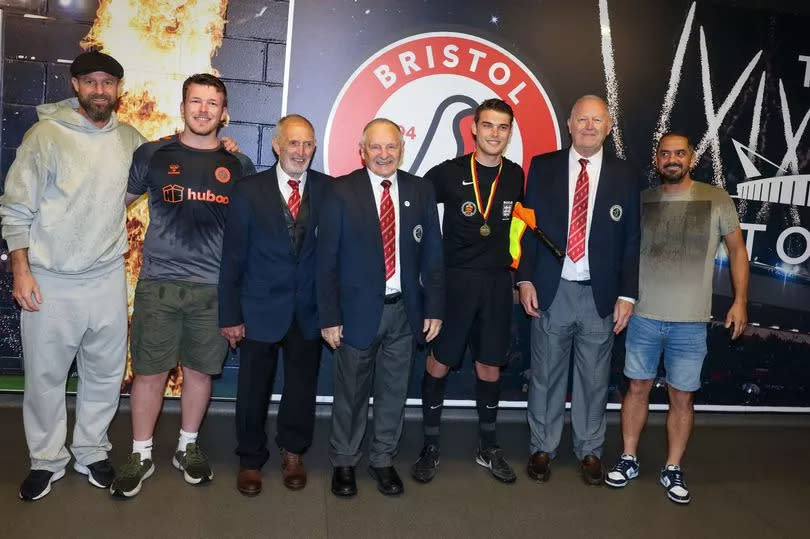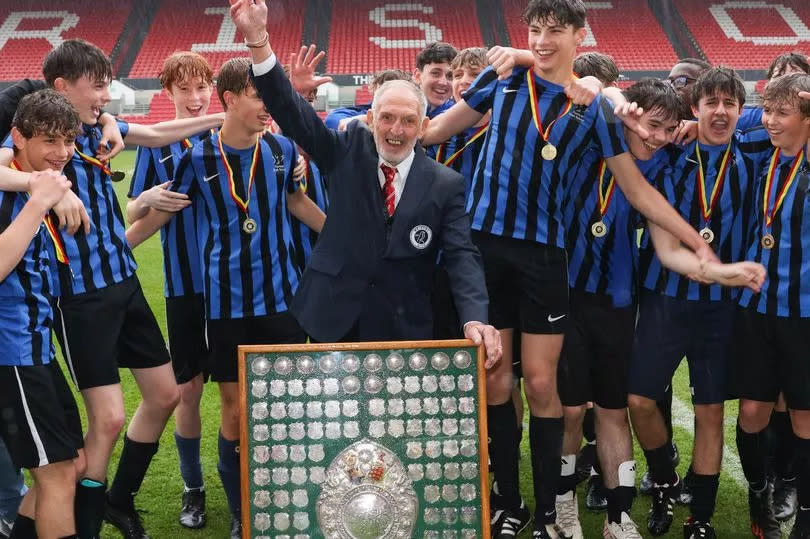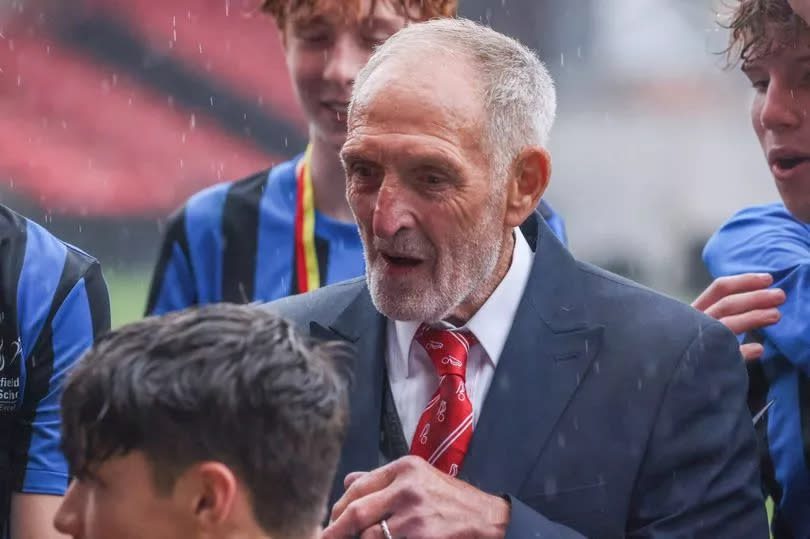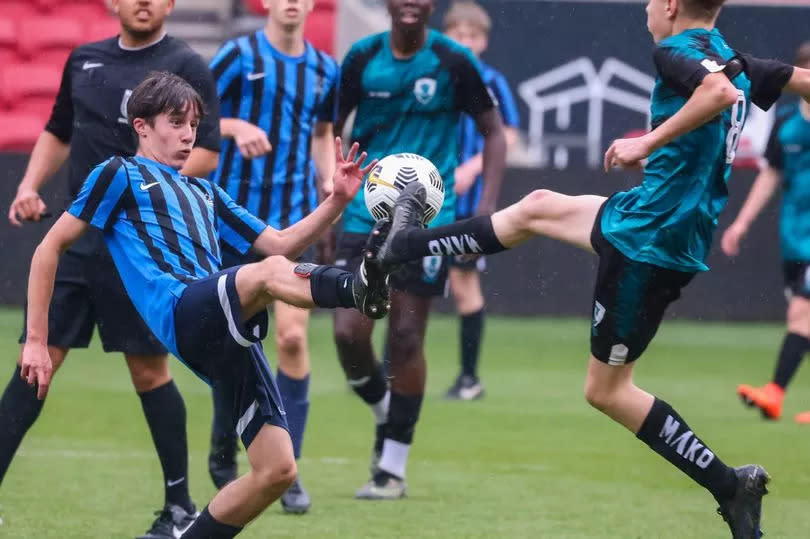'Rock hard football' as legends watch the most important school match in Bristol
“It was thunder and lightning… rock hard football, no punches pulled,” said Bristol City legend Geoff Merrick, from his seat near the pitch at Ashton Gate. But he wasn’t reminiscing about battles with Liverpool or Arsenal back in the 1970s, the defender had a different match in mind - Hartcliffe v Southville.
The two schools met at Ashton Gate in the final of the Woodcock Shield in the early 1960s, and so tough was the game between them that the teachers called it a draw with no extra-time with the scores level at 2-2. With a very young Merrick marshalling the Southville defence, the school team’s goals were scored by Chris Garland - both would go on to illustrious professional careers on the same pitch in BS3.
And on a wet Tuesday night this week, the shield final - potentially the most important game of football that generations of Bristolian boys ever played in - returned to Ashton Gate for the first time in years, with just as much spiky passion as the days of Merrick and Garland, or Alfie Biggs before them.
Read next: Galleries demolition plan heralds new city centre for Bristol
Read more: The story behind how Bristol City icon Chris Garland became immortalised on the side of a pub
It has been the most important game of football that generations of Bristolian boys often ever played in. Since 1907, the final of the Woodcock Shield has been the FA Cup, Champions League and World Cup Final rolled into one for school teams. Tens of thousands of young players have competed to win the large framed shield, and on Tuesday there was no quarter given as Fairfield High School took on Blaise High School in the final.
Hundreds of people - schoolmates, teachers, parents and supporters from each school - made a raucous noise as the two teams of Year 10 boys battled out a 1-0 win for Fairfield High. Thanks to a partnership between the schools organisers and the Bristol City Former Players Association, a mini galaxy of City legends were there to cheer the lads on, and present the winners’ and losers’ medals at the end - alongside Geoff were Dave Rodgers, Trevor Tainton, Louis Carey and Scott Murray.

The passion from the crowd spilled over onto the pitch and emotions ran high. Just as Geoff was talking about how fierce the final he played in was, a melee among the players ended with two bookings and a red card for the Blaise High goalkeeper. Already down 1-0, Blaise battled valiantly with ten men but couldn’t find an equaliser.
At the final whistle, Fairfield’s supporters went crazy, and the scenes on the pitch as the 14 and 15 year olds lifted the shield were reminiscent of the play off finals and promotion trophy wins in the professional game at this time of year.
The competition has run for an astonishing 117 years, and quickly became the one all teenage footballers and PE teachers wanted to win. Open to Year 10 - that’s fourth year in old money - boys’ teams in Bristol and South Gloucestershire, a total of 32 schools entered this season, with five rounds of a knock out contest being whittled down to just two teams in the final.

Those finals became the stuff of legend over the generations, and many a player was spotted by professional scouts. Some of Bristol’s finest football players graced it and went onto become stars for both City and Rovers.
Bristol Rovers legend Alfie Biggs won it twice as the centre forward for Connaught Road School in Knowle West in 1949 and 1950 and captained the side to a third final in 1951 which they lost. Harry Bamford played in the final for St Silas School in St Philips in the 1930s before the Second World War interrupted the start of his professional career - he’d go on to play 486 times for Bristol Rovers as a marauding right back.
More recently Rovers and City star Marcus Stewart played in it, and Ryley Towler’s Mangotsfield School made the final too.
The Shield and the weight of all its history is currently in the custodianship of Cherry Kraus, who co-ordinates much of the school sports for Bristol and is based at Ashton Park School. She said it still holds a powerful pull on the school teams - the 32 schools that entered this year were testament to that. Getting the final back at Ashton Gate for the first time in a few years was also important, she added.
Youth football has shifted away from schools and towards independent clubs, and professional teams can bring young players into their academies long before they even get to secondary school, so schools football has lost the aura and importance it had when Chris Garland and Geoff Merrick lined up for Southville in the early 1960s.
Geoff told Bristol Live the second best moment of his career was captaining England Schoolboys at Wembley against Germany. “When I played, school football at 15 was so serious, it was untrue,” he said. “We used to go for posh dinners after the match. My mum used to try to teach me which knife and fork to use, because it was so complicated.
“That day at Wembley there was something like 82,000 people. A coach came from every school in the country. That was how big it was, everybody had to be there,” he added.

In Bristol, the Woodcock Shield final was the biggest day in the school calendar. Often played at Ashton Gate or Eastville, Chris Garland and Geoff Merrick had the advantage of familiarity when their Shield Final moment came - they’d played on the pitch and in the stadium before.
The pair grew up near each other - Merrick on Garnet Street up the hill in the Chessels part of Bedminster, and Garland in Ashton, most notably in one of the tower blocks built in 1961 next to the ground.
“It was the first time I played here in a proper game,” said Geoff, remembering that final. “But they did used to have invitations where anybody and everybody in the Bedminster area could come and play here in the evening and have maybe ten, 15 or 20 minutes, and if the club liked you, there was the possibility that you could get taken on.”
That was the case for both Merrick and Garland, who were signed up as ‘schoolboys’ by Bristol City by the time the Shield Final against Hartcliffe happened. “But that didn’t mean a thing, to be honest. They didn’t get in touch with me until two or three weeks before I left school and asked me to come and work on the ground staff and play football. So that was a lot after these matches they put together, which would enable young people to come and show Bristol City how good they were.

“That’s something they could do now. It’s not an awful thing to do. A lot of the players who came, they did get contracts,” he added.
That 1964 final itself was Chris Garland’s last game for Southville School - he was two years old than Geoff Merrick, who had just turned 13 when the school took on Hartcliffe - he went on to play for City in two spells either side of time at Chelsea and Leicester City. Merrick joined him at Ashton Gate later in the 1960s, and remained a club stalwart, appearing 367 times for the Robins before both Merrick and Garland became two of the Ashton Gate Eight, whose City careers ended to save the club from bankruptcy in 1982.
“We had a great side, Chris Garland was in the team and many other players who, at the time, were really good footballers. We played on a different pitch,” he said, glancing at the Ashton Gate ‘carpet’ Fairfield and Blaise were currently running around on. “It was the end of the season, and the pitch was pretty rough to be honest. But the game itself was a really hard match. At the end, because of all the effort the kids put into the football, we shared the trophy. Because it was all getting too much - extra time would’ve been too much for the players,” he said.
“We were playing Hartcliffe and that was thunder and lightning. Those two school teams together, during the year in football matches, was amazing. It was just such rock hard football, no punches pulled,” he added.

 Yahoo News
Yahoo News 
